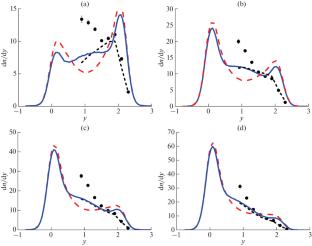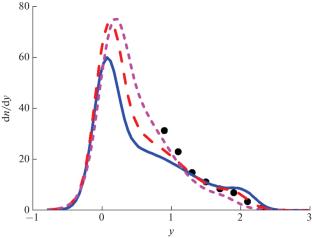Towards Accounting of the Diffraction Dissociation in Nucleus–Nucleus Interactions
IF 0.48
Q4 Physics and Astronomy
Bulletin of the Russian Academy of Sciences: Physics
Pub Date : 2025-08-18
DOI:10.1134/S1062873825711997
引用次数: 0
Abstract
The FRITIOF model, widely used in Monte Carlo generators of artificial events, in particular, in the Geant4 software package, is supplemented by the treatment of the formation and interactions of diffraction-produced systems in nuclei. A good description of the first experimental data of the NICA BM@N collaboration on the production of π+ mesons in interactions of 40Ar nuclei with various nuclei at the energy of 3.2A GeV is obtained.


核-核相互作用中衍射解离的计算
FRITIOF模型广泛用于人工事件的蒙特卡罗生成器,特别是在Geant4软件包中,通过处理原子核中衍射产生的系统的形成和相互作用来补充。本文较好地描述了NICA BM@N关于40Ar核与各种能量为3.2A GeV的核相互作用产生π+介子的第一次实验数据。
本文章由计算机程序翻译,如有差异,请以英文原文为准。
求助全文
约1分钟内获得全文
求助全文
来源期刊

Bulletin of the Russian Academy of Sciences: Physics
Physics and Astronomy-Physics and Astronomy (all)
CiteScore
0.90
自引率
0.00%
发文量
251
期刊介绍:
Bulletin of the Russian Academy of Sciences: Physics is an international peer reviewed journal published with the participation of the Russian Academy of Sciences. It presents full-text articles (regular, letters to the editor, reviews) with the most recent results in miscellaneous fields of physics and astronomy: nuclear physics, cosmic rays, condensed matter physics, plasma physics, optics and photonics, nanotechnologies, solar and astrophysics, physical applications in material sciences, life sciences, etc. Bulletin of the Russian Academy of Sciences: Physics focuses on the most relevant multidisciplinary topics in natural sciences, both fundamental and applied. Manuscripts can be submitted in Russian and English languages and are subject to peer review. Accepted articles are usually combined in thematic issues on certain topics according to the journal editorial policy. Authors featured in the journal represent renowned scientific laboratories and institutes from different countries, including large international collaborations. There are globally recognized researchers among the authors: Nobel laureates and recipients of other awards, and members of national academies of sciences and international scientific societies.
 求助内容:
求助内容: 应助结果提醒方式:
应助结果提醒方式:


